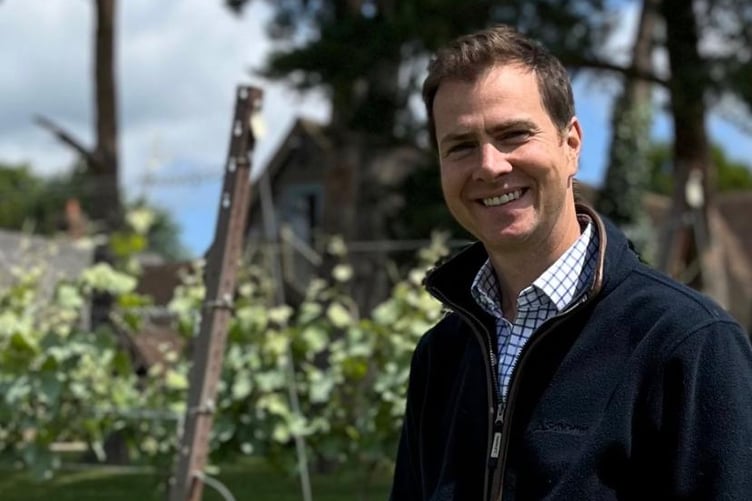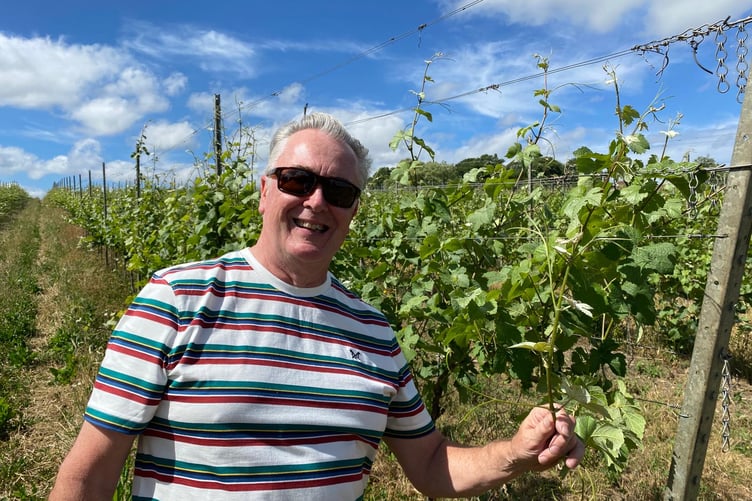Across our sun-drenched chalk hills and once-pastoral farmland, vineyards and winemaking are thriving.
Last week was English Wine Week, a chance for the industry to toast its success. And rightly so, as the sector has seen remarkable growth.
In just ten years, the number of vineyards across the country has risen to over 1,000, with approximately 125 wineries now operating – up from fewer than 100 a decade ago.
Wine production reached a record 12.2 million bottles in 2022, and this figure is forecast to double to 25 million by 2032, thanks largely to the growing reputation of the region’s sparkling wines.
Exports are flourishing too, doubling between 2019 and 2022 to markets such as the US, Norway, and Japan. English sparkling wines from Hampshire, Surrey, Kent, and Sussex have even outshone French Champagnes in blind tastings, cementing their growing international prestige.

But is everything really rosé-tinted for growers in our counties and beyond?
For Andrew Debham, founder of Otium Wine Estate near Selborne, and John Wilkins, commercial director at Penn Croft Vineyard and Itasca Wines in Crondall, the answer is nuanced. English wine is thriving, they agree, but challenges loom.
Andrew and his wife Emily moved to their Upper Farringdon farm in November 2020 with a clear ambition: to create a vineyard producing high-quality grapes for traditional method sparkling wine.
Their journey mirrors that of many new entrants, driven by passion for wine. But he warns the current growth in vineyard planting may soon outstrip market demand.
“Figures estimate that the area of UK vineyards planted has more than doubled in the last 10 years and is set to continue to grow at a similar rate.” Andrew says.
“There’s a three or four-year lag when making traditional sparkling wine, and actually, from planting, there’s a seven-year lag. All the planting in the last six or seven years hasn’t come onto the market yet – so we’re yet to see the real impact.”
He adds: “It’s a relatively small market with not a lot of flexibility. If one large producer goes bust, it could have big knock-on effects for an industry that isn’t yet established enough to weather them.”
Andrew believes the sector may eventually reach saturation. “Nine out of ten articles you read give you this rosy picture that climate change is making things more viable, that we’re winning awards, making great wine – and that’s true.
“But all industries have cycles, and because ours is so nascent, there might not be much tolerance to these cycles.”
As Andrew points out, producers often see no revenue for up to seven years after planting, while ongoing maintenance costs remain high. Combined with relatively small yields per acre compared to continental Europe, this underpins the premium price tag of English bottles.
While diversification into wine is often seen as a solution for struggling farms, Andrew warns it is not for everyone. “Compared to other agricultural sectors, wine making is growing fast. Producers who struggled in the past are branching out, but eventually it will reach saturation point.”
He believes some regulation may become necessary. “The Government might need to regulate it a bit more, perhaps limiting where everyone could plant wine grapes. But they would say, ‘We don’t want overregulation, we want innovation.’”
Despite his caution, Andrew remains excited about the future, with plans to release the estate’s first vintage next summer.
A few miles away in Crondall, John Wilkins is overseeing rapid expansion at Penn Croft and Itasca Wines, whose state-of-the-art winery opened in 2020. Formerly a holiday rep, John’s love of wine was first sparked by Rioja while leading tours in Spain. Now he is firmly rooted in English wine’s growth trajectory.
“Anybody who’s got a spare bit of land wants to plant some grapes – and this is just the start,” John says. “It’s fantastic and exciting for us.”
Their winery has quickly earned a reputation as a regional model, with advanced water recycling systems and sustainable designs that draw vineyard owners from across the South East to visit. Recently, they planted a new vineyard adjacent to the winery to enhance their visitor experience, alongside the popular Cellar Door Café.

For John, the reason behind the boom is simple: climate change. “It’s getting warmer here,” he explains. “Some of the Champagne houses are buying vineyards in southern England because the temperature here is now what it was in Champagne 20 years ago. That’s a big factor for sparkling wine.”
This trend is backed by data. French Champagne houses such as Taittinger and Pommery have invested millions in land across Kent and Hampshire, betting on Britain’s rising temperatures and chalky soils to produce high-quality fizz.
While reds remain challenging – “It’s not quite warm enough for the reds I like, but that’s subjective,” John admits – he is confident about their whites and sparklings. “We’re producing fabulous results,” he says, citing blind tastings where English sparklings have outperformed Champagne.
Looking ahead, John’s team is building a second winery in Essex, an area with promising soils and warming microclimates. “The county’s really going to become the centre of English winemaking,” he predicts.
However, he acknowledges that pricing remains an issue. “There’s still a perception that English wine is expensive compared to Champagne. Obviously, we don’t have the yields they have in Chile, France, Spain, or Italy. Educating people is key – I do a lot of work with WineGB just letting the public know how good our wines are.”
Scarcity also plays a role. “It is expensive because we only have 1,000 bottles of this, or one vineyard of Bacchus that gave us just 400 bottles. Our warehouse is full of bottles in stillages, 500 at a time, not earning any money for two or three years – so these are major issues.”
Despite this, John believes there is plenty of room for growth before fears of oversupply become reality. “In my opinion, it’s still fairly localised and regionalised. We don’t have big numbers at the moment.”
This optimism is underpinned by robust domestic demand. According to WineGB, around 70 percent of English wine sales are sparkling wines, with Bacchus leading among still wines. The domestic market remains the primary consumer, but export growth and wine tourism, with vineyards opening tasting rooms, restaurants, and accommodation, is providing additional income streams and resilience.
For example, Otium Wine Estates provides luxury accommodation to capitalise on the growing wine tourism market, while the Cellar Door restaurant at Penn Croft offers wine tastings alongside locally produced dishes.
“There are so many possibilities and opportunities in the industry. It just keeps growing,” John says. “Each year the London Wine Fair gets bigger, WineGB gets bigger.”
From farms across Surrey and Hampshire to Kent, Essex, and beyond, English wine is no longer a novelty. Rising temperatures, growing expertise, and international recognition suggest a bright future.
But producers like Andrew and John know it will require careful management, market education, and realism about inevitable cycles of growth, consolidation, and renewal.
It may not all be rosé – but for now, the outlook remains sparkling.




Comments
This article has no comments yet. Be the first to leave a comment.